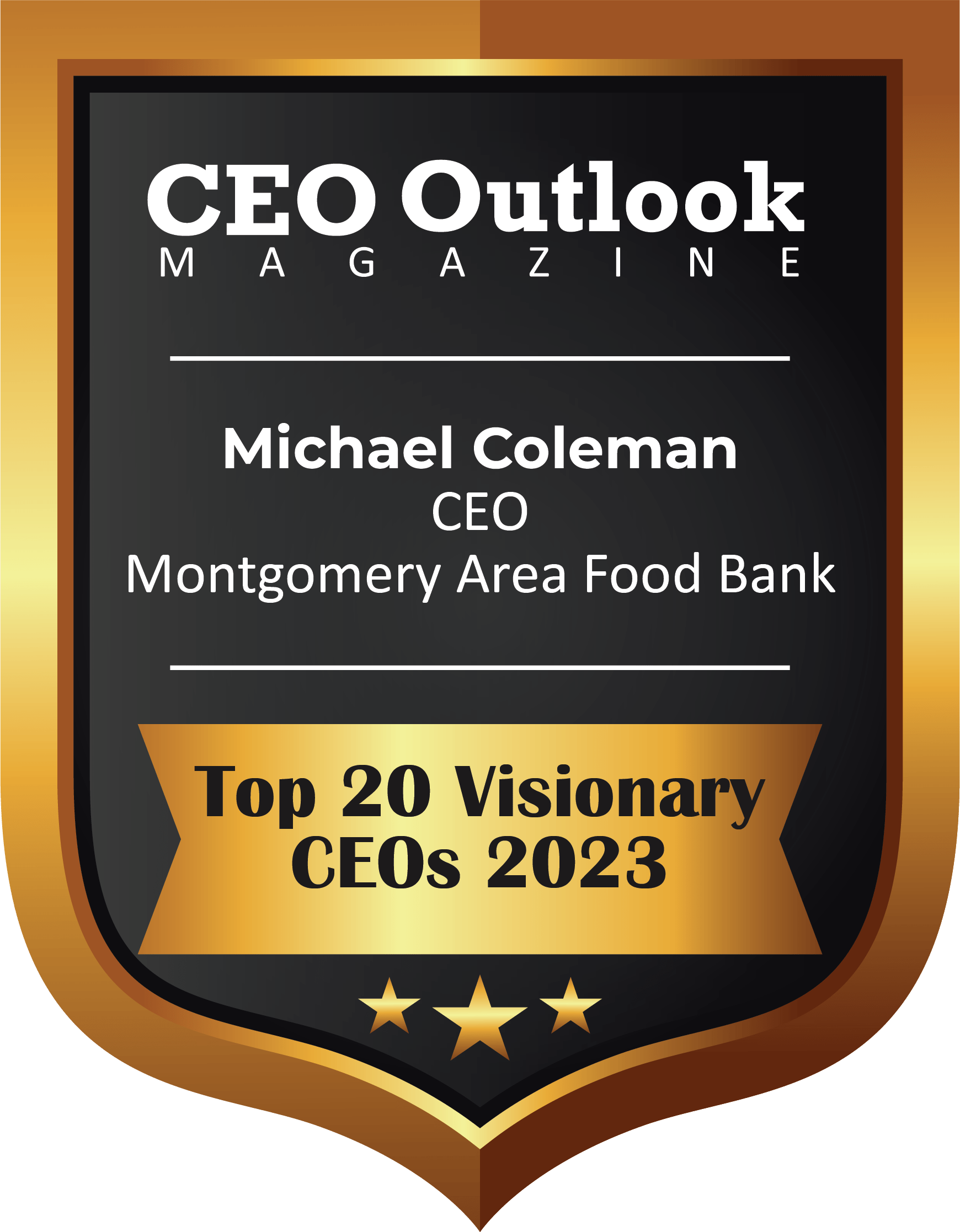Michael Coleman | CEO | Montgomery Area Food Bank

Michael Coleman
CEO

" Because Montgomery Area Food Bank is responsible for a territory that is spread out over 35 counties, sourcing, storing, and distributing food is costly. We never want money to be the reason someone is going hungry. We would love for your readers to go to our website at mafb.org and see all the ways they can get involved and support us if they are able. "
Fighting A Crisis with Dedicated Purpose
The U.S. food security crisis is increasing with each passing day. Assessments propose 23 million people reside in so-called “food deserts”—mostly rural areas where there is little to no access to fresh food, and low-income neighborhoods with poor access to healthy food. The pandemic, which has ushered in over 50 million Americans encountering food insecurity, has demonstrated the drawback in the food system and supply chain resiliency. Americans in lower-income areas spend 30-40 percent of their income on food. The food security crisis in the United States has recently instigated the present administration to propose tens of billions of dollars of new federal aid to at-risk American households.
With a new danger of recession looming and millions of Americans still out of work, one of the country’s most urgent concerns has only been exacerbated: hunger. In communities nationwide, the lines at food pantries are getting longer and longer, and there’s no clear end in sight. Before the pandemic, the number of families undergoing food insecurity — a shortage of consistent access to sufficient food for an active, healthy life — had steadily declined.
But now, as economic fluctuation and a health predicament take over, new assessments point to some of the most alarming rates of food insecurity in the United States in years. About 19 million people, or approximately 6% of the residents, lived in a food desert, and 2.1 million homes lived in a food desert in 2015, according to the USDA, the numbers are nothing but growing.
Michael Coleman, CEO, Montgomery Area Food Bank has been trying to address this issue in regions his food bank can access. He says, “Covid pandemic highlighted how vulnerable and at-risk so many people living in the United States are to hunger and food insecurity. The reality is that the USDA and other food supplement programs are simply not enough to meet the demand. Therefore, we have to utilize the best methods available to source food and reduce the billions of pounds of food that unnecessarily end up in landfills each year.”
Of course, this means tackling old problems with different solutions which often require nontraditional thinking. For instance, in the state of Alabama, they have a problem with feral hogs damaging crops and local farmlands. They reproduce at such a large rate that controlling the population is incredibly difficult. “However, we are beginning a collaboration with those who capture and euthanize these animals and take them to state-licensed facilities so the meat can be processed in accordance with federal, state, and local laws and donated to the food bank,” says Michael. “Through this process, we are turning a state problem into a regular source of protein. While this is just one example, we must continue to take advantage of all resources available to us.”
Michael is a pioneering leader leading the Montgomery Area Food Bank with strong will and commitment. Established in 1986 through the efforts of the local United Way Community Council and under the umbrella of the American Red Cross, Montgomery Area Food Bank became a certified affiliate of Feeding America (previously known as America’s Second Harvest) in 1989. For 36 years, Montgomery Area Food Bank’s mission has been to nourish the hungry, educate and mobilize the community, engage in partnerships that advance self-sufficiency, and gather and distribute food to those in need.
Montgomery Area Food Bank’s primary battle in the food bank industry is waging war against hunger and food insecurity among the most vulnerable neighbors. Feeding America and the 200 food banks in its network are doing incredibly innovative things to serve the communities better. The organization is working hard to use technology better to source more healthy food, to assist in collaborative work with the private and public sectors, to work towards solving some of the most complex sourcing and distribution problems, and diligently search for opportunities to address the core issues of poverty in rural communities and communities of persons of color.
The Change Maker
But Michael notes that to be a change maker, it should begin from your home; for him, it is his organization. He shares that to be an organization that is vibrant and constantly moving forward, leaders must be empowered to problem-solve and make decisions. Unfortunately, too many organizations run aground because the CEO won’t allow any decisions of consequence to be made outside of their control. This is inefficient and ineffective for organizations with multiple departments, resulting in operational delays due to bottlenecking. All too often, organizations suffer from what is known as “paralysis through analysis.” Michael intends to develop leaders who can conduct mental risk assessments, consider all avenues, determine which is best, and move forward promptly.
Through this approach, he conveys that leaders are trusted and critical to organizational success. “People reading this may think, “If you are empowering your leaders to make key decisions, what is the cost of all the mistakes that surely take place along the way?” In my experience, the most influential teacher has always been a failure,” says Michael. “Failure has a remarkable way of humbling employees by demonstrating that they don’t have all the answers and still have some things to learn. If handled correctly, failure helps to bring about a coachable spirit and provides employees with lessons that remain with them over a lifetime.”
Michael believes the long-term success of an organization must involve effectively building trust, loyalty, and enthusiasm with leaders. The desire and expectation are that this approach trickles down to all employees within the organization. Like leaders, If employees are allowed to be part of the process, they are more likely to take ownership and pride in their performance. Over time, this culture will begin to take root, one in which employees embrace and understand their role in the organization’s overall success.
The Secret to Leadership & Success
Michael always found it helpful to surround himself with people of exceptional talent, often with much more ability than him. Specifically, gifted people who are remarkable in areas in which he is not talented. “For instance, I love discussing big ideas and studying innovative approaches to problems. I get energized talking about vision and direction and how I want our organization to move forward. In contrast, I am not a great detail person. Detailed tasks, while essential, drain me of energy,” he explains. “I know it is part of my job and that I have to do it with the same excellence as other tasks, but I am mentally exhausted afterward. Therefore, I don’t particularly appreciate spending as much time on those tasks. However, I surround myself with key leaders who thrive in these environments because those tasks are vital. This approach helps create a well-balanced team where one skill set is not valued over the others.”
There is something critical to grasp here. For Michael to understand what qualities he needed in others, he spent years learning his strengths and weaknesses. “Why several different things have informed my understanding of myself, the most valuable is having people who can speak truth into your life,” he elucidates. “I am not talking about people who tell you what you want to hear but those who tell you what you need to hear, those who are not afraid to hold up a mirror to your face. I know firsthand how painful some of those conversations can be. We would all like to see ourselves through rose-colored glasses.” He adds, “As leaders, though, we must be in tune with the reality of our strengths and especially our weaknesses. I have found that having 3-4 people in your life willing to show you your true self is invaluable; painful but invaluable if you want to become the best leader possible.”
His advice for becoming a good leader is to be authentic. “Be the same person you are on Tuesday morning as you are on Saturday night. Of course, authenticity requires vulnerability, which I believe is a quality you see in the most influential leaders. But understand being vulnerable comes with risks. These risks create the most significant barriers to transparency and vulnerability,” he says. “Many leaders miss out on golden opportunities to relationally connect with those they lead because of a fear of projecting weakness in any real sense. I believe showing your flaws, mistakes, and failures allows others to better navigate their shortcomings.”
While leadership isn’t often discussed in terms of sharing failures, it is an essential component because there will likely be more failures along the way than successes. As per Michael, if young leaders don’t know how to grow from failure, how will they ever reach their full potential? And if C-Suite executives aren’t willing to reveal their struggles and how they overcome them, how will those who follow ever find their way? Authenticity is critical in developing trust, loyalty, and commitment, which they all value in their employees.
Fighting Hunger Crisis
Michael has been nothing but authentic. He is authentic in leading his team, genuine in fighting for a cause, and authentic in implementing solutions that enhance how the company works for its mission.
According to Michael, most people need help understanding the difference between a food bank and a food pantry. Food banks source, store, and distribute food to the pantries while these pantries turn around and distribute the food to the local residents in need. So they are vital to the food distribution process. “Due to the increased demand and the rural nature of our coverage area, we need as many community partners as possible. We are always recruiting other nonprofits and churches to assist us in getting these vital resources to the community because the need never goes away,” says Michael. Montgomery Area Food Bank is later transitioning to a fully automated inventory system that will drastically reduce human error, eliminate most manual inventories, and allow their agencies to order products online. This will continue to improve the time it takes to receive food products and get them into the hands of those in need.
Some of Montgomery Area Food Bank’s programs, such as its child backpack program, are relatively traditional. One thing is known that children who depend on the school breakfast and lunch program often go home and do not eat until the following day. This is especially troubling over a weekend. To combat this, Montgomery Area Food Bank has its pantries put together food packs in gallon-size Ziploc bags and put them in the student’s backpacks to take home. This is much more discreet and helps students avoid being shamed or bullied by their classmates.
They have other initiatives that help them combat veteran hunger and college hunger. “The issue with veteran hunger is significant to me, given my time in the Army. So many veterans struggle with making ends meet but are too proud to admit they need help, much less actively seek it out,” adds Michael. “Therefore, we must work to destigmatize hunger and support them in their time of need. The same is true of college hunger. Statistics show that so many adults drop out of college at two-year and four-year programs because they can’t afford to feed themselves. By recognizing this as a student retention issue, many colleges are getting smart about the need to assist students with food insecurity issues.”
Montgomery Area Food Bank, under the aegis of Michael, has been surging ahead in its mission to feed those in need and is fast becoming an example of exemplary work being accomplished in this time of crisis. More and more food banks armed with food pantries are trying to do their part pan-U.S., but with the current economic turmoil, there is only so much they can do as funds from the government are beginning to dry and supply chain issues escalate. “Because Montgomery Area Food Bank is responsible for a territory that is spread out over 35 counties, sourcing, storing, and distributing food is costly. We never want money to be the reason someone is going hungry. We would love for your readers to go to our website at mafb.org and see all the ways they can get involved and support us if they are able,” says Michael. “I want every person battling hunger and food insecurity to know they are valued. Food bankers from all across the Feeding America network see our neighbors in need through the lens of “what could be” and not “what currently is”. We know that many in need are actually some of the most gifted in our community. Therefore, we engage in this battle, not out of pity, but in order to unlease our neighbor’s remarkable abilities and empower them to take control of their lives so they in turn become a blessing to others in need.
























































